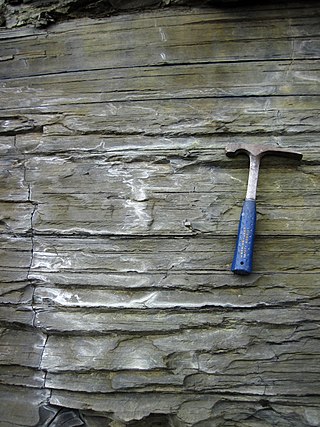
Shale is a fine-grained, clastic sedimentary rock formed from mud that is a mix of flakes of clay minerals (hydrous aluminium phyllosilicates, e.g. kaolin, Al2Si2O5(OH)4) and tiny fragments (silt-sized particles) of other minerals, especially quartz and calcite. Shale is characterized by its tendency to split into thin layers (laminae) less than one centimeter in thickness. This property is called fissility. Shale is the most common sedimentary rock.
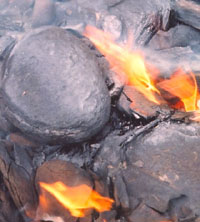
Oil shale is an organic-rich fine-grained sedimentary rock containing kerogen from which liquid hydrocarbons can be produced. In addition to kerogen, general composition of oil shales constitutes inorganic substance and bitumens. Based on their deposition environment, oil shales are classified as marine, lacustrine and terrestrial oil shales. Oil shales differ from oil-bearing shales, shale deposits that contain petroleum that is sometimes produced from drilled wells. Examples of oil-bearing shales are the Bakken Formation, Pierre Shale, Niobrara Formation, and Eagle Ford Formation. Accordingly, shale oil produced from oil shale should not be confused with tight oil, which is also frequently called shale oil.

Chert is a hard, fine-grained sedimentary rock composed of microcrystalline or cryptocrystalline quartz, the mineral form of silicon dioxide (SiO2). Chert is characteristically of biological origin, but may also occur inorganically as a chemical precipitate or a diagenetic replacement, as in petrified wood.

Kerogen is solid, insoluble organic matter in sedimentary rocks. It consists of a variety of organic materials, including dead plants, algae, and other microorganisms, that have been compressed and heated by geological processes. Altogether kerogen is estimated to contain 1016 tons of carbon. This makes it the most abundant source of organic compounds on earth, exceeding the total organic content of living matter 10,000-fold.

Palynology is the study of microorganisms and microscopic fragments of mega-organisms that are composed of acid-resistant organic material and occur in sediments, sedimentary rocks, and even some metasedimentary rocks. Palynomorphs are the microscopic, acid-resistant organic remains and debris produced by a wide variety plants, animals, and Protista that have existed since the late Proterozoic.

A microfossil is a fossil that is generally between 0.001 mm and 1 mm in size, the visual study of which requires the use of light or electron microscopy. A fossil which can be studied with the naked eye or low-powered magnification, such as a hand lens, is referred to as a macrofossil.
The Canadian System of Soil Classification is more closely related to the American system than any other, but they differ in several ways. The Canadian system is designed to cover only Canadian soils. The Canadian system dispenses with the sub-order hierarchical level. Solonetzic and Gleysolic soils are differentiated at the order level.
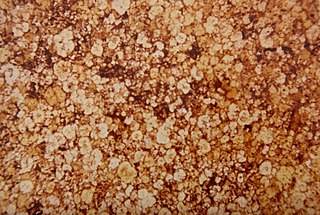
Torbanite, also known historically as boghead coal or kerosene shale, is a variety of fine-grained black oil shale. It usually occurs as lenticular masses, often associated with deposits of Permian coals. Torbanite is classified as lacustrine type oil shale. A similar mineral, cannel coal, is classified as being a terrestrial form of oil shale, not a lacustrine type.
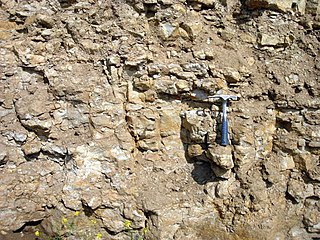
Oil shale geology is a branch of geologic sciences which studies the formation and composition of oil shales–fine-grained sedimentary rocks containing significant amounts of kerogen, and belonging to the group of sapropel fuels. Oil shale formation takes place in a number of depositional settings and has considerable compositional variation. Oil shales can be classified by their composition or by their depositional environment. Much of the organic matter in oil shales is of algal origin, but may also include remains of vascular land plants. Three major type of organic matter (macerals) in oil shale are telalginite, lamalginite, and bituminite. Some oil shale deposits also contain metals which include vanadium, zinc, copper, and uranium.
Oil shale reserves refers to oil shale resources that are economically recoverable under current economic conditions and technological abilities. Oil shale deposits range from small presently economically unrecoverable to large potentially recoverable resources. Defining oil shale reserves is difficult, as the chemical composition of different oil shales, as well as their kerogen content and extraction technologies, vary significantly. The economic feasibility of oil shale extraction is highly dependent on the price of conventional oil; if the price of crude oil per barrel is less than the production price per barrel of oil shale, it is uneconomic.

Kukersite is a light-brown marine type oil shale of Ordovician age. It is found in the Baltic Oil Shale Basin in Estonia and North-West Russia. It is of the lowest Upper Ordovician formation, formed some 460 million years ago. It was named after the German name of the Kukruse Manor in the north-east of Estonia by the Russian paleobotanist Mikhail Zalessky in 1917. Some minor kukersite resources occur in sedimentary basins of Michigan, Illinois, Wisconsin, North Dakota, and Oklahoma in North America and in the Amadeus and Canning basins of Australia.

The Marcellus Formation or the Marcellus Shale is a Middle Devonian age unit of sedimentary rock found in eastern North America. Named for a distinctive outcrop near the village of Marcellus, New York, in the United States, it extends throughout much of the Appalachian Basin.
Lamalginite is a structured organic matter (alginite) in sapropel, composed of thin-walled colonial or unicellular algae that occur as distinct laminae, cryptically interbedded with mineral matter. It displays few or no recognisable biologic structures. Lamalginite fluoresce brightly in shades of yellow under blue/ultraviolet light. The term of lamalginite was introduced by Adrian C. Hutton of the University of Wollongong.
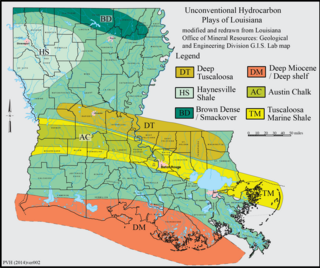
The Haynesville Shale is an informal, popular name for a Jurassic Period rock formation that underlies large parts of southwestern Arkansas, northwest Louisiana, and East Texas. It lies at depths of 10,500 to 13,000 feet below the land’s surface. It is part of a large rock formation which is known by geologists as the Haynesville Formation. The Haynesville Shale underlies an area of about 9,000 square miles and averages about 200 to 300 feet thick. The Haynesville Shale is overlain by sandstone of the Cotton Valley Group and underlain by limestone of the Smackover Formation.

Permineralization is a process of fossilization of bones and tissues in which mineral deposits form internal casts of organisms. Carried by water, these minerals fill the spaces within organic tissue. Because of the nature of the casts, permineralization is particularly useful in studies of the internal structures of organisms, usually of plants.
Oil shale in Belarus is a large, but undeveloped energy resource. While the reserves have been known for decades, they remain unexplored due to oil shale's high ash and sulphur content, low heat of combustion and high cost of extraction and processing. However, depletion of conventional petroleum and natural gas reserves, as well as a high degree of reliance on imported hydrocarbons from Russia, have recently renewed interest in oil shale exploration in the country.

The Cozy Dell Shale is a geologic formation of middle Eocene age that crops out in the Santa Ynez Mountains and Topatopa Mountains of California, extending from north of Fillmore in Ventura County westward to near Point Arguello, north of Santa Barbara. Because the Cozy Dell easily weathers to a clay-rich soil, it crops out infrequently and generally forms dense stands of chaparral in saddles between peaks and ridges of the more resistant Matilija and Coldwater formations.
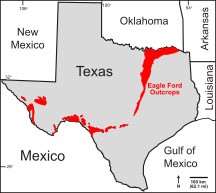
The Eagle Ford Group is a sedimentary rock formation deposited during the Cenomanian and Turonian ages of the Late Cretaceous over much of the modern-day state of Texas. The Eagle Ford is predominantly composed of organic matter-rich fossiliferous marine shales and marls with interbedded thin limestones. It derives its name from outcrops on the banks of the West Fork of the Trinity River near the old community of Eagle Ford, which is now a neighborhood within the city of Dallas. The Eagle Ford outcrop belt trends from the Oklahoma-Texas border southward to San Antonio, westward to the Rio Grande, Big Bend National Park, and the Quitman Mountains of West Texas. It also occurs in the subsurface of East Texas and South Texas, where it is the source rock for oil found in the Woodbine, Austin Chalk, and the Buda Limestone, and is produced unconventionally in South Texas and the "Eaglebine" play of East Texas. The Eagle Ford was one of the most actively drilled targets for unconventional oil and gas in the United States in 2010, but its output had dropped sharply by 2015. By the summer of 2016, Eagle Ford spending had dropped by two-thirds from $30 billion in 2014 to $10 billion, according to an analysis from the research firm Wood Mackenzie. This strike has been the hardest hit of any oil fields in the world. The spending was, however, expected to increase to $11.6 billion in 2017. A full recovery is not expected any time soon.

Lacustrine deposits are sedimentary rock formations which formed in the bottom of ancient lakes. A common characteristic of lacustrine deposits is that a river or stream channel has carried sediment into the basin. Lacustrine deposits form in all lake types including rift graben lakes, oxbow lakes, glacial lakes, and crater lakes. Lacustrine environments, like seas, are large bodies of water. They share similar sedimentary deposits which are mainly composed of low-energy particle sizes. Lacustrine deposits are typically very well sorted with highly laminated beds of silts, clays, and occasionally carbonates. In regards to geologic time, lakes are temporary and once they no longer receive water, they dry up and leave a formation.

The Francevillian B Formation, also known as the Francevillian Formation or FB2 in scientific research, is a geologic formation of black shale provinces close to the town of Franceville, Gabon from where it gets its name from. The formation was deposited between 2.14-2.08 Ga in the Palaeoproterozoic, and, uniquely, has not experienced any thermal overprinting due to diagenesis after burial nor significant metamorphism since it was deposited, unlike other formations deposited around the same time. The formation contains possible fossils, including the macroscopic "Francevillian Biota", which has been suggested by some authors to represent the oldest known multicellular organisms, though other authors have questioned the supposed biological origin of the structures, and have suggested that they may instead be inorganic, such as artifacts of diagenesis.















